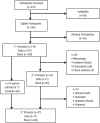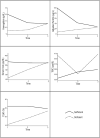The prevalence of anemia and iron deficiency among pregnant Ghanaian women, a longitudinal study
- PMID: 33760869
- PMCID: PMC7990185
- DOI: 10.1371/journal.pone.0248754
The prevalence of anemia and iron deficiency among pregnant Ghanaian women, a longitudinal study
Abstract
Background: Gestational iron deficiency (ID) can be deleterious to mother and fetus. However, iron status is not routinely measured during pregnancy in Ghana. Therefore, the scope of ID in this population is unknown.
Objective: To determine the prevalence of anemia and ID across pregnancy in the Central Region of Ghana.
Methods: Women were recruited during their 1st trimester of pregnancy (< 13 weeks; n = 116) and followed through to their 2nd (n = 71) and 3rd (n = 71) trimesters. Data on socio-demographic variables, weekly intake of iron-rich foods and vitamin C-rich fruits were collected. Blood samples were drawn and the concentrations of hemoglobin (Hb), ferritin (Ft), serum iron (sFe), total iron binding capacity (TIBC), were measured; transferrin saturation (TSAT) was calculated. Repeated measures ANOVA was used to determine change in anemia and iron variables over time with groups categorized by 1st trimester iron status.
Results: Participants were 27.1 ± 5.2 years, on average. Prevalence of anemia (Hb <11.0 g/dL) was 37%, 63%, 58%; ID (Ft <15 μg/L) was 16%, 20%, 38%; and iron deficiency anemia (IDA; based on low Ft and Hb) was 6%, 12%, 25% in 1st, 2nd and 3rd trimesters, respectively. Significant changes in Hb, Ft and TIBC occurred across time. Iron status at 1st trimester had a significant effect on 2nd but not 3rd trimester iron status.
Conclusions: ID is prevalent in pregnant Ghanaian women, especially during the 3rd trimester. Anemia is a major public health problem during pregnancy in Ghana with a significant proportion due to factors other than ID.
Conflict of interest statement
The authors have declared that no competing interests exist.
Figures
References
Publication types
MeSH terms
Substances
LinkOut - more resources
Full Text Sources
Other Literature Sources



